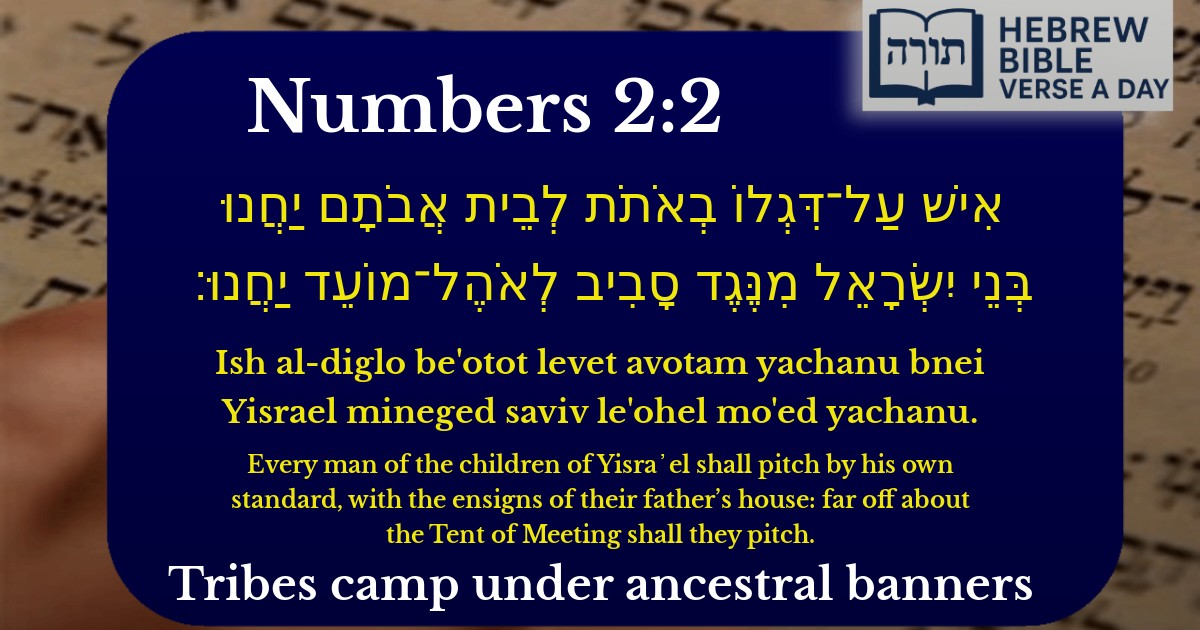Join Our Newsletter To Be Informed When New Videos Are Posted
Join the thousands of fellow Studends who rely on our videos to learn how to read the bible in Hebrew for free!
Hebrew Text
אִישׁ עַל־דִּגְלוֹ בְאֹתֹת לְבֵית אֲבֹתָם יַחֲנוּ בְּנֵי יִשְׂרָאֵל מִנֶּגֶד סָבִיב לְאֹהֶל־מוֹעֵד יַחֲנוּ׃
English Translation
Every man of the children of Yisra᾽el shall pitch by his own standard, with the ensigns of their father’s house: far off about the Tent of Meeting shall they pitch.
Transliteration
Ish al-diglo be'otot levet avotam yachanu bnei Yisrael mineged saviv le'ohel mo'ed yachanu.
Hebrew Leining Text
אִ֣ישׁ עַל־דִּגְל֤וֹ בְאֹתֹת֙ לְבֵ֣ית אֲבֹתָ֔ם יַחֲנ֖וּ בְּנֵ֣י יִשְׂרָאֵ֑ל מִנֶּ֕גֶד סָבִ֥יב לְאֹֽהֶל־מוֹעֵ֖ד יַחֲנֽוּ׃
Parasha Commentary
📚 Talmud Citations
This verse is quoted in the Talmud.
📖 Yoma 54b
The verse is referenced in a discussion about the arrangement of the Israelite camps around the Tabernacle.
📖 Sotah 36b
The verse is cited in a discussion about the standards and banners of the tribes of Israel.


Organization of the Camp
The verse describes the orderly arrangement of the Israelite camp during their travels in the wilderness, with each tribe encamped under its own banner (deglo) and family insignia (os), surrounding the Mishkan (Tabernacle). This structure reflects both physical and spiritual organization, as taught by Rashi (Bamidbar 2:2) and the Midrash (Bamidbar Rabbah 2:3).
Symbolism of the Banners
According to the Midrash (Bamidbar Rabbah 2:7), each tribe's banner had a unique color corresponding to the precious stones on the Choshen (High Priest's breastplate), symbolizing their distinct spiritual qualities. Ramban (Bamidbar 2:2) explains that the banners fostered unity while preserving tribal identity, preventing disputes over camping positions.
Positioning Around the Mishkan
Spiritual Lessons
The Talmud (Shabbos 92a) derives from this arrangement that proper Jewish living requires both structure (seder) and sanctity (kedushah). The Kli Yakar (Bamidbar 2:2) adds that the distance maintained from the Mishkan ("far off") teaches reverence for holy spaces, while still maintaining connection to them.
Historical Continuity
The Or HaChaim (Bamidbar 2:2) notes that this formation was prophetically designed by Yaakov Avinu and later implemented by Moshe, showing how ancestral merit (zechus avos) guides Israel's national structure. The Baal HaTurim connects the word "deglo" (his banner) to "dodim" (Song of Songs 6:10), symbolizing Israel's loving relationship with Hashem.